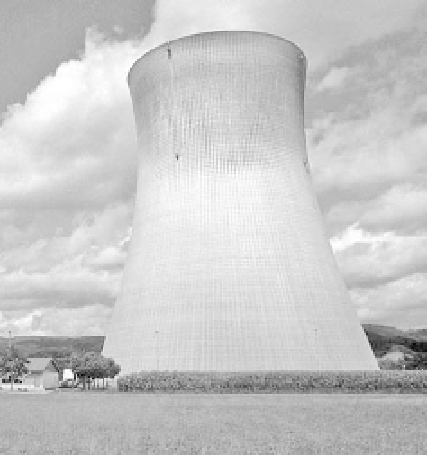Environmental Engineering Reference
In-Depth Information
about 270 Gm
3
in the year 2000 (91% of this for once-
through cooling). This was about 48% of all withdrawals
and 52% of fresh surface water use. Irrigation was the sec-
ond largest user, drawing some 30% of fresh surface
water. But because consumptive uses account for at least
40%-50% in irrigation (and for much more with drip irri-
gation) and for less than 3% of water drawn by thermo-
electric plants, the actual claim of electricity generation
was less than 10 Gm
3
, an equivalent of about 20% of
the consumptive use drawn by public waterworks.
There is insufficient information to calculate an
accurate global weighted average of once-through and
closed-loop cooling needs. The U.S. mean is about 80
L/kWh, but the country has an exceptionally large share
of once-through cooling, and the global mean is most
likely less than 40 L/kWh. Thus worldwide water with-
drawals for thermoelectric plants were no higher than
500 km
3
in the year 2000, and even if consumptive use
were to amount to 5% of that total, it would be no more
than 25 km
3
. Hydroelectric generation itself is another
massive nonconsumptive use of water, but reservoirs
needed for its smooth functioning lose water by evapora-
tion, and in tropical regions, where large parts of the res-
ervoir surfaces are covered by aquatic plants, the losses
are even higher by enhanced evapotranspiration. These
losses average 17 L/kWh for U.S. hydroelectricity gener-
ation and as much as 26 L/kWh in California (Gleick
1993). A liberal global mean of 20 L/kWh would trans-
late to an annual loss of less than 60 km
3
.
Most water claims in coal mining fall are 2-5 L/GJ for
surface extraction and 20 L/GJ for deep mining. Oil ex-
traction needs 5-10 L/GJ. Enhanced oil recovery in Al-
berta oil fields has required less than 30 L/GJ (Peachey
2005), but elsewhere the rates have been several times
higher (100-200 L/GJ) and can be as much as 500-
11.6 Large European concrete wet cooling tower.
up to only about 0.03% of the throughput. The differ-
ence between the once-through and closed-loop systems
is well illustrated by the data gathered every five years in
USGS water use surveys.
The 2004 survey shows that in the year 2000 plants
with once-through cooling (accounting for about 40%
of installed thermal generation capacity) needed nearly
180 L/kWh, whereas plants with closed-loop (or air-
cooled) systems withdrew only about 12 L/kWh
(USGS 2004). Depending on the power plant efficiency,
tower design, and environmental conditions, water losses
in wet cooling towers are only 1.5-2.6 L/kWh of gener-
ated electricity. FBC plants and CC generation can lower
the rate below 1 L/kWh, and in dry cooling towers
water consumption is less than 0.1 L/kWh. In aggre-
gate, U.S. thermal electricity generation has been the
nation's largest user of water since 1965; it withdrew




